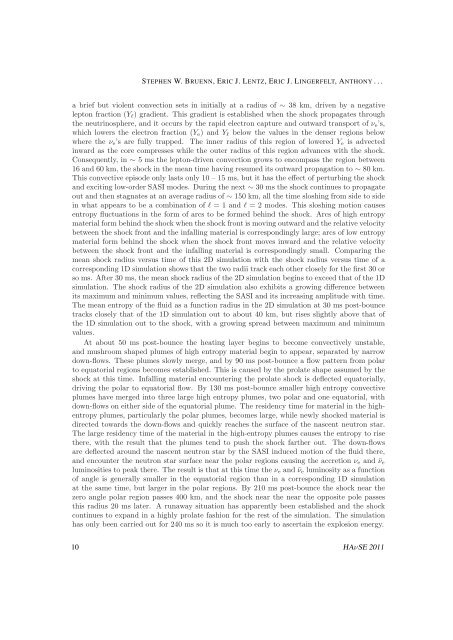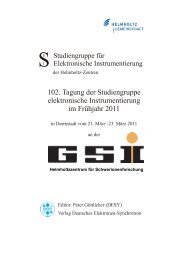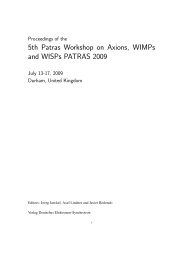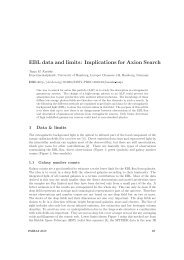Hamburg Neutrinos from Supernova Explosions ... - DESY Library
Hamburg Neutrinos from Supernova Explosions ... - DESY Library
Hamburg Neutrinos from Supernova Explosions ... - DESY Library
Create successful ePaper yourself
Turn your PDF publications into a flip-book with our unique Google optimized e-Paper software.
STEPHEN W. BRUENN, ERIC J. LENTZ, ERIC J. LINGERFELT, ANTHONY . . .<br />
a brief but violent convection sets in initially at a radius of ∼ 38 km, driven by a negative<br />
lepton fraction (Yℓ) gradient. This gradient is established when the shock propagates through<br />
the neutrinosphere, and it occurs by the rapid electron capture and outward transport of νe’s,<br />
which lowers the electron fraction (Ye) and Yℓ below the values in the denser regions below<br />
where the νe’s are fully trapped. The inner radius of this region of lowered Ye is advected<br />
inward as the core compresses while the outer radius of this region advances with the shock.<br />
Consequently, in ∼ 5 ms the lepton-driven convection grows to encompass the region between<br />
16 and 60 km, the shock in the mean time having resumed its outward propagation to ∼ 80 km.<br />
This convective episode only lasts only 10 – 15 ms, but it has the effect of perturbing the shock<br />
and exciting low-order SASI modes. During the next ∼ 30 ms the shock continues to propagate<br />
out and then stagnates at an average radius of ∼ 150 km, all the time sloshing <strong>from</strong> side to side<br />
in what appears to be a combination of ℓ = 1 and ℓ = 2 modes. This sloshing motion causes<br />
entropy fluctuations in the form of arcs to be formed behind the shock. Arcs of high entropy<br />
material form behind the shock when the shock front is moving outward and the relative velocity<br />
between the shock front and the infalling material is correspondingly large; arcs of low entropy<br />
material form behind the shock when the shock front moves inward and the relative velocity<br />
between the shock front and the infalling material is correspondingly small. Comparing the<br />
mean shock radius versus time of this 2D simulation with the shock radius versus time of a<br />
corresponding 1D simulation shows that the two radii track each other closely for the first 30 or<br />
so ms. After 30 ms, the mean shock radius of the 2D simulation begins to exceed that of the 1D<br />
simulation. The shock radius of the 2D simulation also exhibits a growing difference between<br />
its maximum and minimum values, reflecting the SASI and its increasing amplitude with time.<br />
The mean entropy of the fluid as a function radius in the 2D simulation at 30 ms post-bounce<br />
tracks closely that of the 1D simulation out to about 40 km, but rises slightly above that of<br />
the 1D simulation out to the shock, with a growing spread between maximum and minimum<br />
values.<br />
At about 50 ms post-bounce the heating layer begins to become convectively unstable,<br />
and mushroom shaped plumes of high entropy material begin to appear, separated by narrow<br />
down-flows. These plumes slowly merge, and by 90 ms post-bounce a flow pattern <strong>from</strong> polar<br />
to equatorial regions becomes established. This is caused by the prolate shape assumed by the<br />
shock at this time. Infalling material encountering the prolate shock is deflected equatorially,<br />
driving the polar to equatorial flow. By 130 ms post-bounce smaller high entropy convective<br />
plumes have merged into three large high entropy plumes, two polar and one equatorial, with<br />
down-flows on either side of the equatorial plume. The residency time for material in the highentropy<br />
plumes, particularly the polar plumes, becomes large, while newly shocked material is<br />
directed towards the down-flows and quickly reaches the surface of the nascent neutron star.<br />
The large residency time of the material in the high-entropy plumes causes the entropy to rise<br />
there, with the result that the plumes tend to push the shock farther out. The down-flows<br />
are deflected around the nascent neutron star by the SASI induced motion of the fluid there,<br />
and encounter the neutron star surface near the polar regions causing the accretion νe and ¯νe<br />
luminosities to peak there. The result is that at this time the νe and ¯νe luminosity as a function<br />
of angle is generally smaller in the equatorial region than in a corresponding 1D simulation<br />
at the same time, but larger in the polar regions. By 210 ms post-bounce the shock near the<br />
zero angle polar region passes 400 km, and the shock near the near the opposite pole passes<br />
this radius 20 ms later. A runaway situation has apparently been established and the shock<br />
continues to expand in a highly prolate fashion for the rest of the simulation. The simulation<br />
has only been carried out for 240 ms so it is much too early to ascertain the explosion energy.<br />
10 8<br />
HAνSE 2011








